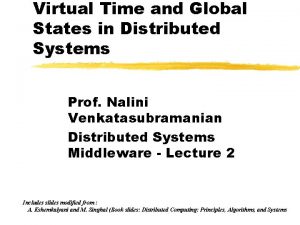Computer Science Computer systems 19022021 J 27601 Virtual







- Slides: 7

Computer Science Computer systems 19/02/2021 (J 276/01) Virtual Networks

Computer Science Computer systems 19 February 2021 Virtual Networks (J 276/01) Learning Objectives: 1. Define what a virtual network is and its key characteristics 2. Explain how virtual private networks are used within every day life Key Terms: Virtual Network, Virtual Private Network, LAN, WAN, data packets, switch, hub, server.

Standard Network Computer Science Computer systems • Here's a reminder of a standard network set up. (J 276/01) • Typical LANs use physical hardware to connect the hub to the workstations, server and WAP. • The alternative to this is a ‘virtual network’

Virtual Network Finance Sales Computer Science Computer systems • Virtual networks make use of software to divide devices on a LAN into smaller groups. (J 276/01) • The whole LAN is still physically connected by cables, but the ‘virtual network’ of devices created through software restricted from accessing any of the other computers on the LAN. So they appear to be a completely separate network within the larger one. Manufacturing The LAN has been subdivided into three virtual networks (VLAN)

Benefits of VLANs Computer Science Computer systems 5 minute challenge (J 276/01) Identify all of the advantages you can think of, of using VLAN’s in a large organisation • Teams can have their own VLANs to communicate and share information • Its easier to configure software setups for individual teams. • Reduced network traffic because data is only sent to member of the VLAN • More secure – Information is only shared with the members of the VLAN REMEMBER: LANs are created using physical hardware (cables). Virtual networks are created using software.

Virtual Private Network (VPN) Chal leng Iden tif that y exam p you or yo les of VP N u uses r teache S r e Computer Science Computer systems Virtual private networks are similar but work on a larger scale (J 276/01) ALL – Research what a VPN is and how it works Most – Demonstrate an understanding of how VPNS are used within the world and provide technical understanding and relevant examples. Some – Use key terminology such as protocols & tunnelling whilst explaining what a VPN is

Computer Science Computer systems VPN – Key Points (J 276/01) • Similar set up but using a larger WAN such as the internet • Users across the world can log in, work and collaborate on their own private network. • Network is created through software and uses encryption and other software to ensure that all communication is secure • In a VPN, Packets that are sent are placed within an outer packet that only that particular VPN can understand using special protocols. This is the process known as tunnelling. Simple Example – A class teacher logging on to an area of the school network from home.
 English science and blank are my favorite subject
English science and blank are my favorite subject Has virtual functions and accessible non-virtual destructor
Has virtual functions and accessible non-virtual destructor Virtual time and global states of distributed systems
Virtual time and global states of distributed systems Decision support systems and intelligent systems
Decision support systems and intelligent systems Dicapine
Dicapine Embedded systems vs cyber physical systems
Embedded systems vs cyber physical systems Elegant systems
Elegant systems Coa virtual lab iit kharagpur
Coa virtual lab iit kharagpur













